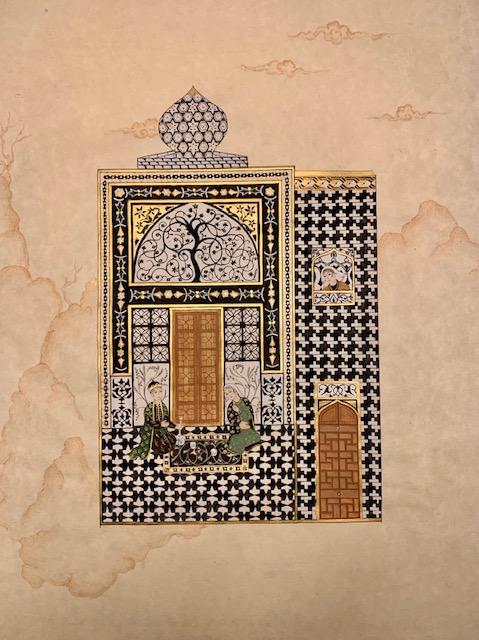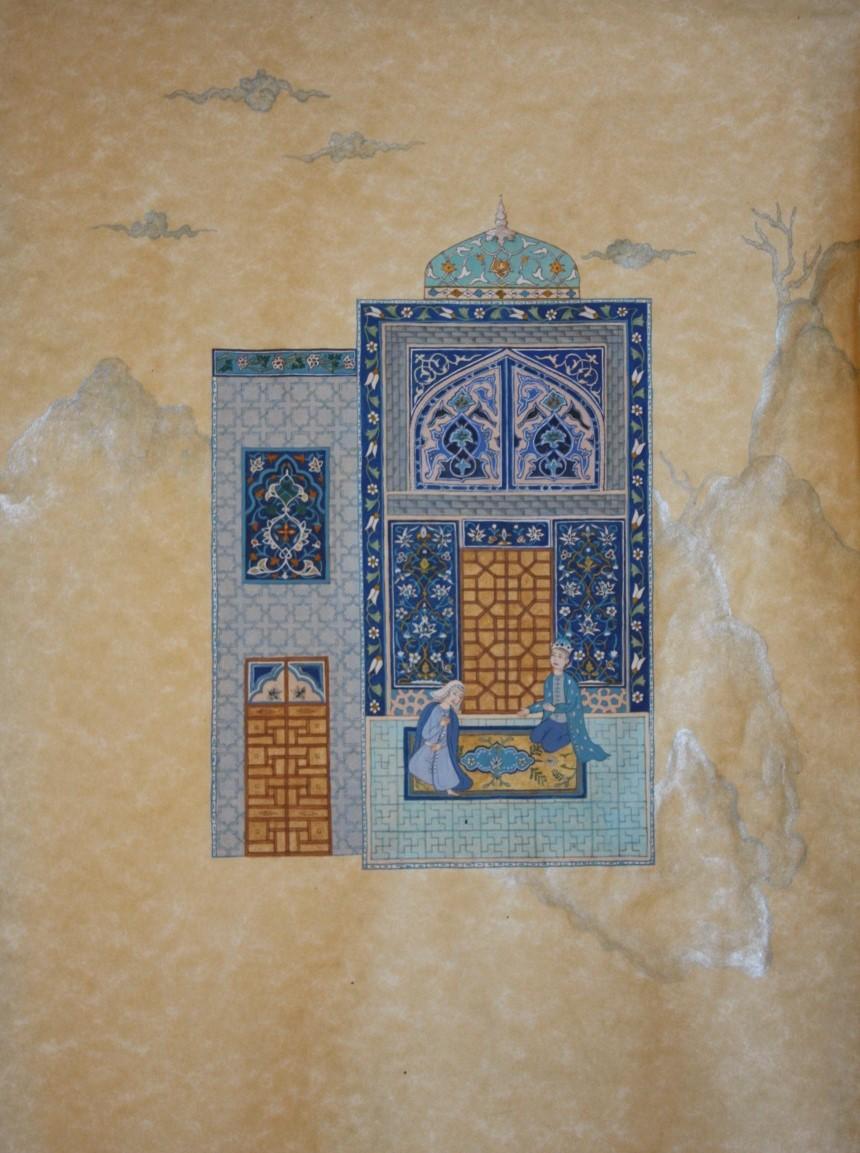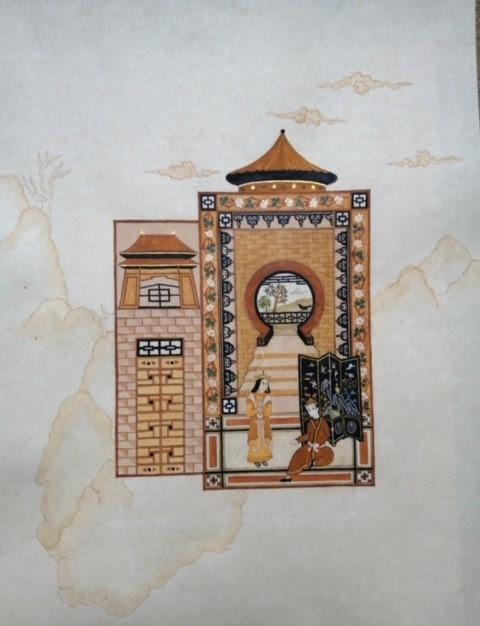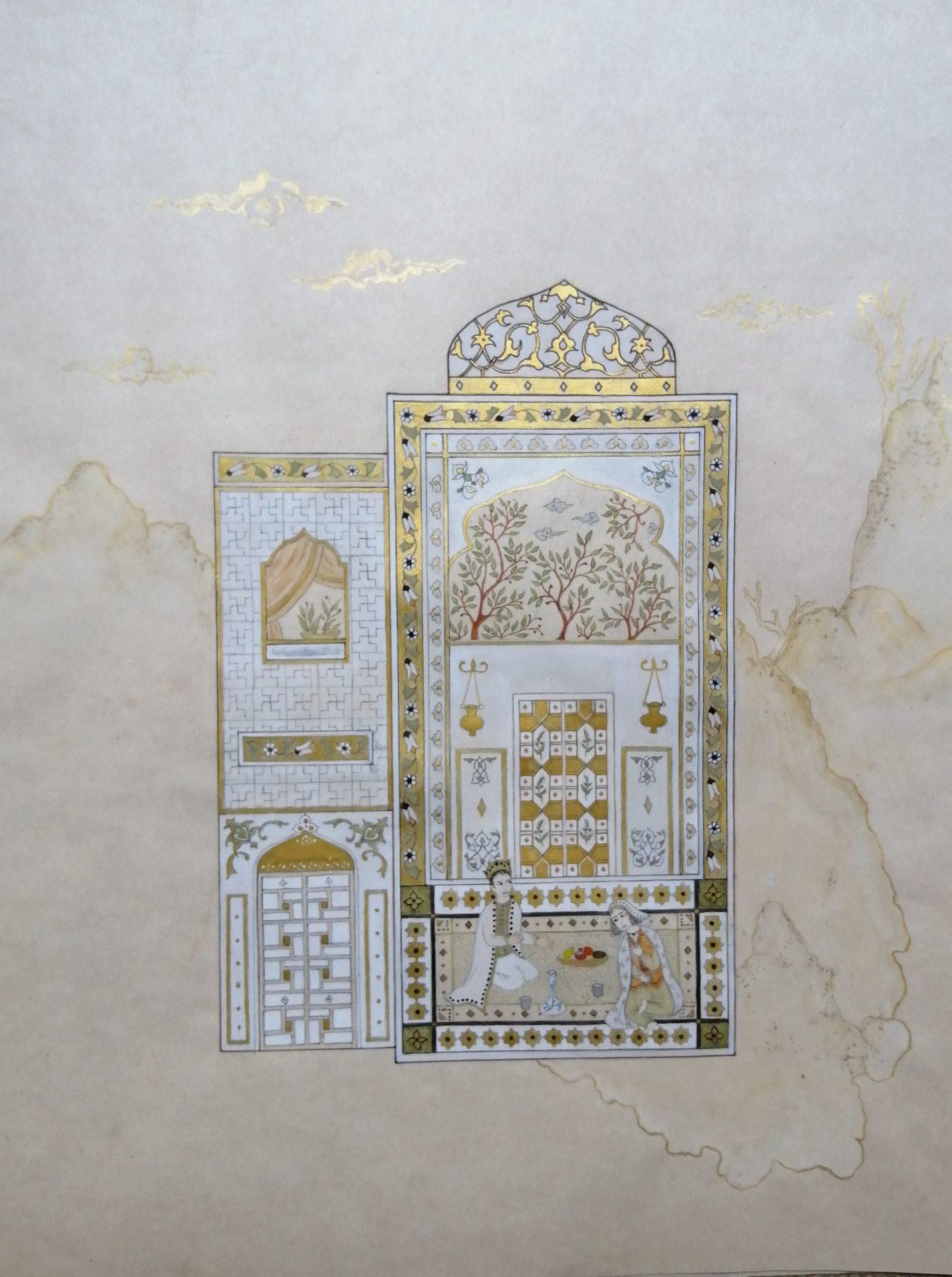Persian miniatures (Negārgarī Irani)

Hunting scene by Abbas Moayeri

Séance des amoureux by Abbas Moayeri, 1993

Details of painting, black and gold, by Abbas Moayeri
The Art of Persian miniature
Western artists discovered Persian miniature at the beginning of the 20th century, notably following exhibitions of Persian art in Munich in 1910, Paris in 1912 and London in 1931.
As early as the 11th century, Persian miniatures featured heroes from epic literature and poetry. Persian miniatures reached a turning point with the invasion of the Mongols and during the Timurid period (12th and 16th centuries). The Chinese influence was reflected in both design and materials.
Persian paintings were originally designed to illustrate texts; from the 16th century onwards, they were also produced on separate sheets.
The symbiosis of Persian and Indian styles gave rise to the Mughal school in the 16th century. Humayun, son of Babur (founder of the Mughal dynasty), discovered Persian illuminations and miniatures at the Safavid court in Persia (1501-1736). He chose two young Persian painters to follow him to India, introducing the taste for manuscript illumination to the court. Their role would be vital in the evolution of the Indian miniature style.
From the XIIIth century to the XVIIth, miniatures were used to illustrate manuscripts, especially the classics of Persian miniature: the shahnameh of Ferdowsi, the khamseh of Nizâmi, the boustan or the golestan of Saadi. Their small size was linked to this function as well as the commonly adopted vertical orientation of miniatures.
The paper used from the 9th/10th century was made of linen fibres. Colours were obtained from natural or artificial pigments. Most brushes were made of squirrel tail hair. Hair of persian cats was also used.
Miniature is always painted inside a frame which represents an opening towards an ideal world, made of beauty and dream. “Beauty is the perception of eternity”. Today its size may vary and the paper called “peau d’éléphant” is aesthetically the most closed to the paper used in the past. Colours must be soft in general. Nowadays, gouache is used for surfaces.
The classical composition includes generally: a garden surrounded by a barrier; water – canal, river, lake -; a key figure under a kiosk or a canopy; courtiers and servants but also hunters. Characters seem to float in space: they are not attached to the land on which they are painted. The charm of Persian miniature comes from its elegance, slight curves and the refinement of its very numerous details. Miniature must not take into account the perspective or too much realism: it opens to the dream, to “Persian paradises”.
Trained in Persian miniatures techniques by Abbas Moayeri, Marie-Noëlle Robert says "The staging of certain Persian miniatures reminds me of opera staging. The stories of the mythical couples of Persian literature, Leila and Madjun, Khosrow and Shirin… recall those of Tristan and Yseult, of Romeo and Juliet".
http://papier-cisele.com/fr#pageart9
Persian miniature leaves room to imagination and individual sensitivity, even if techniques are traditional, and allows each one to project in very different worlds, as miniatures presented below can demonstrate.
Great master miniaturist Abbas Moayeri has painted sumptuous traditional miniatures highly prized by collectors. Painter and sculptor, “he has also engaged in pictorial research, experimenting with an original creative path nourished by centuries of Persian art and translated by a Western technique that allows the non-Iranian layman to enter into the transfigured symbolism of a marvellous world of legend, poetry and ancient wisdom”
Continuing the tradition after the departure of Abbas Moayeri, Persian miniature is still taught in France at Paris-Ateliers.

Abbas Moayeri
Homage to Abbas Moayeri
Our great master in Persian miniature passed away at the end of autumn 2020. He knew our admiration, he also had our affection. His personality federated, his openness to others seduced, his affectionate warmth prevailed. Beyond the artistic technique, he took us into history, from Persia to Iran. As a recognized painter, a miniaturist of international renown, he will always have his place in the world of art. As for us, it is with all the more emotion and pride that we continue the practice of this art of Persian miniature that Abbas Moayeri wanted more than anything to transmit.
Persian miniatures by Hélène Barrieu, Claudine Gillot, Ma Padioleau, Gérard Verrouil
students of Master Abbas Moayeri in Paris
The King of Persia Bahrâm Gûr and the princesses of seven pavillions
after a poem by Nizami (12th century), by Claudine Gillot

Bahrâm Gûr and the princess of India in the black pavilion

Bahrâm Gûr and the princess of Byzance in the yellow pavilion

Bahrâm Gûr and the princess of Khorasmi in the green pavilion

Bahrâm Gûr and the princess of Slavonia in the red pavilion

Bahrâm Gûr and the princess of Maghreb in the blue pavilion

Bahrâm Gûr and the Chinese princess in the Sandal pavilion

Bahrâm Gûr and the princess of Persia in the white pavilion

Paradise garden, after the Bihbahan manuscript (1938),
Istanbul Museum of Turkish Art, by Claudine Gillot, 2021

Eden garden, after the Bihbahan manuscript (1938),
Istanbul Museum of Turkish Art, by Claudine Gillot, 2023

Battle scene by Gérard Verrouil, 2022

Yousouf celebrated at the court before his marriage to Zoulayka,
from a miniature of Sheikh Mohammad,
by Gerard Verrouil

Abdul Kassem carries his library by Claudine Gillot

The Annunciation by Claudine Gillot

The musician and the philosopher in a garden by Ma Padioleau

The prince and the bird by Ma Padioleau

Shirin in the bath by Claudine Gillot

Farahd and Shirin by Claudine Gillot

The seven dormants by Claudine Gillot

Dervich antiquarian in Ispahan by Claudine Gillot

Miniature Illumination by Helene Barrieu

Courtiers by Hélène Barrieu

Bijen and Manijeh by Claudine Gillot

Delayed letter by Claudine Gillot

Ferdowsi and the poets of Ghazneh,
after a miniature from the Shahnameh, 9th century
bt Ma Padioleau, 2023

Romance by Ma Padioleau

In the name of love by Ma Padioleau, 2024
from a 15th-century miniature

Noe's Arch by Helene Barrieu, 2024